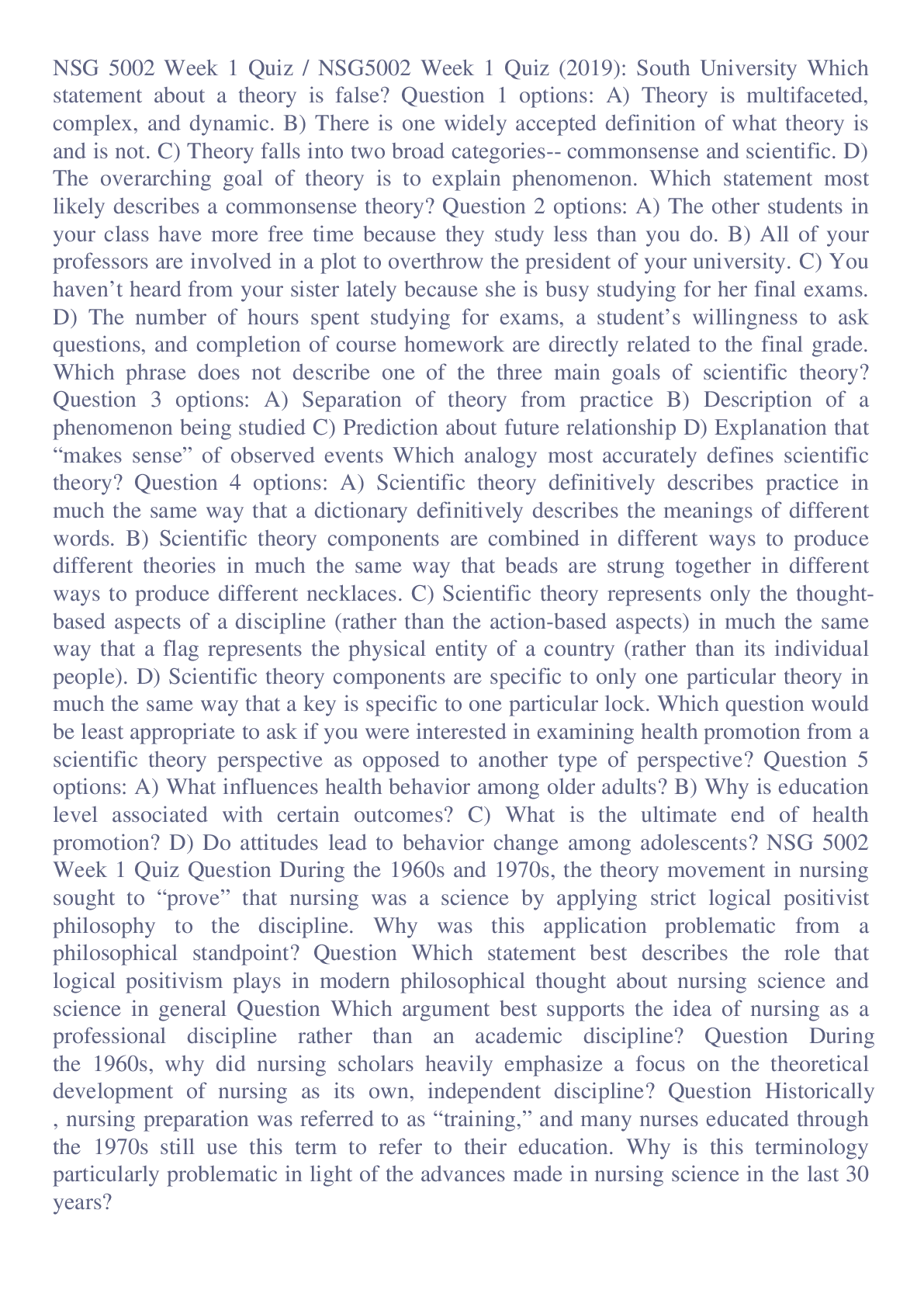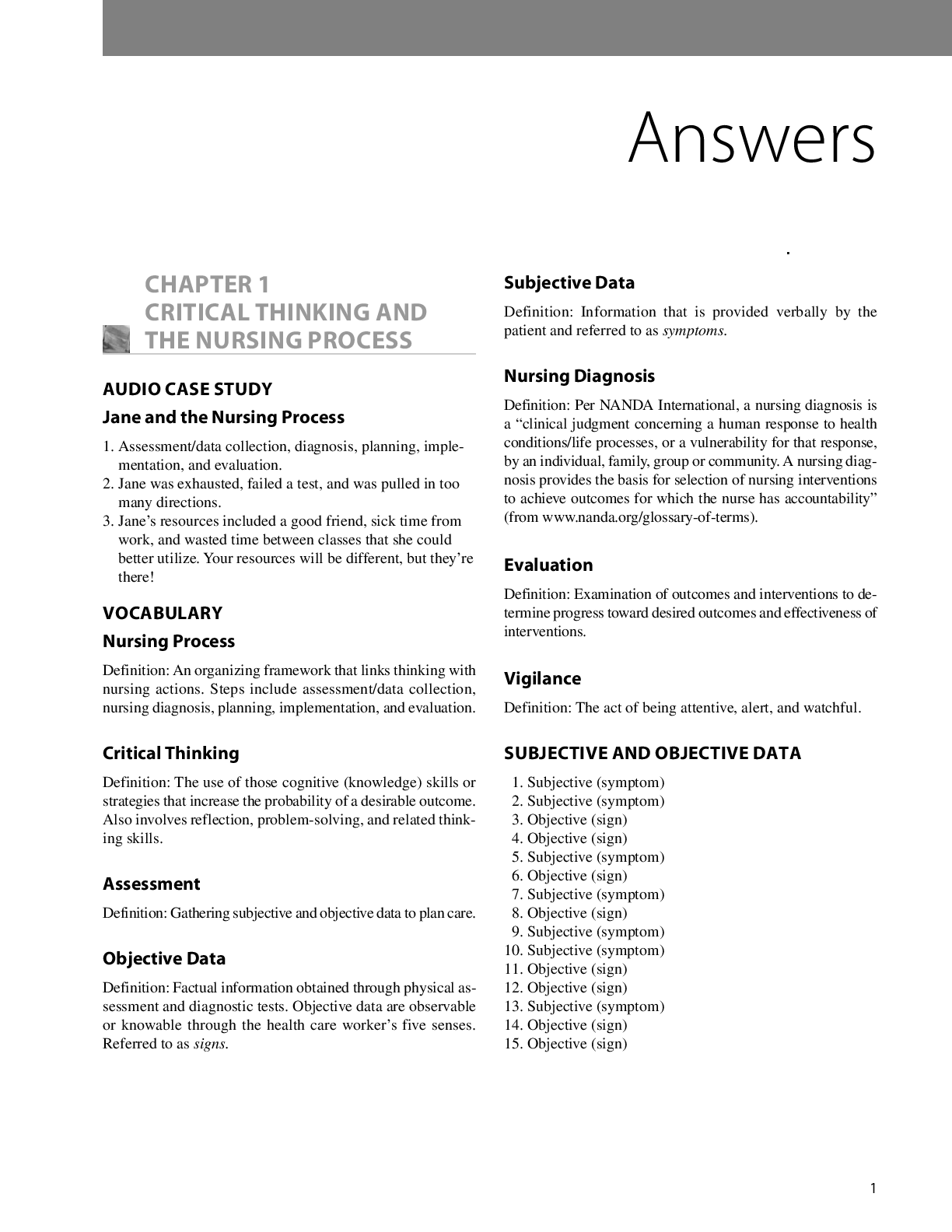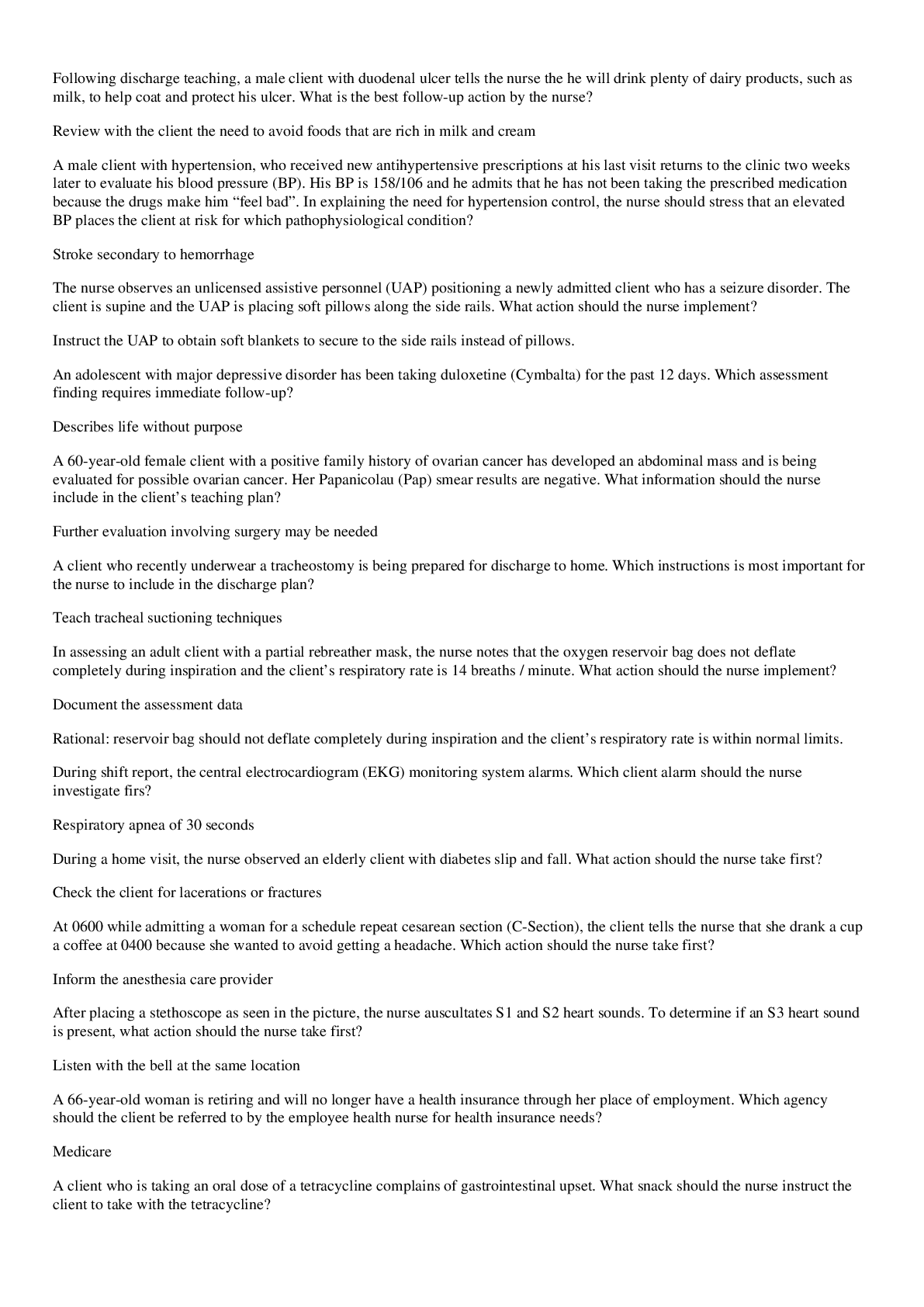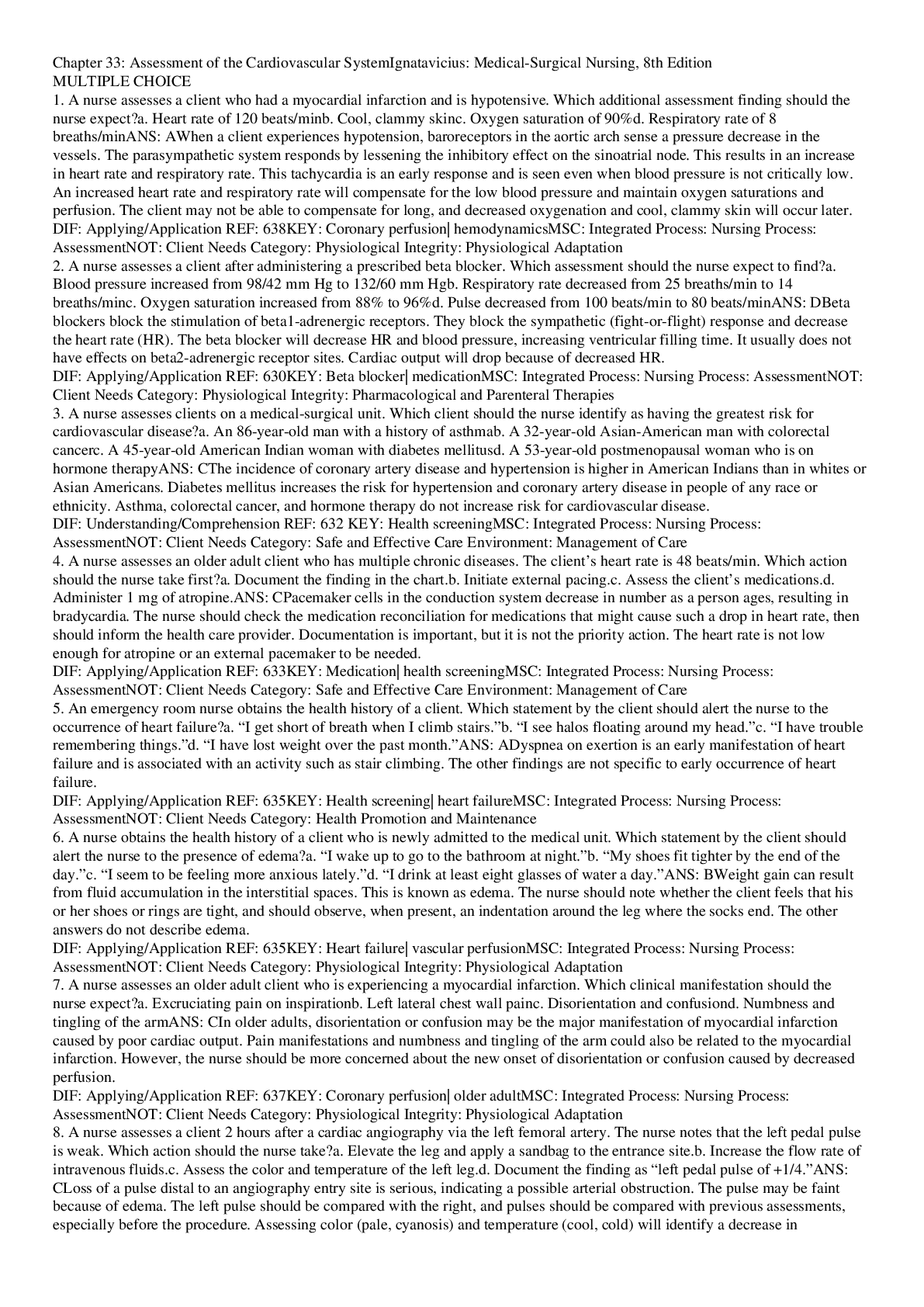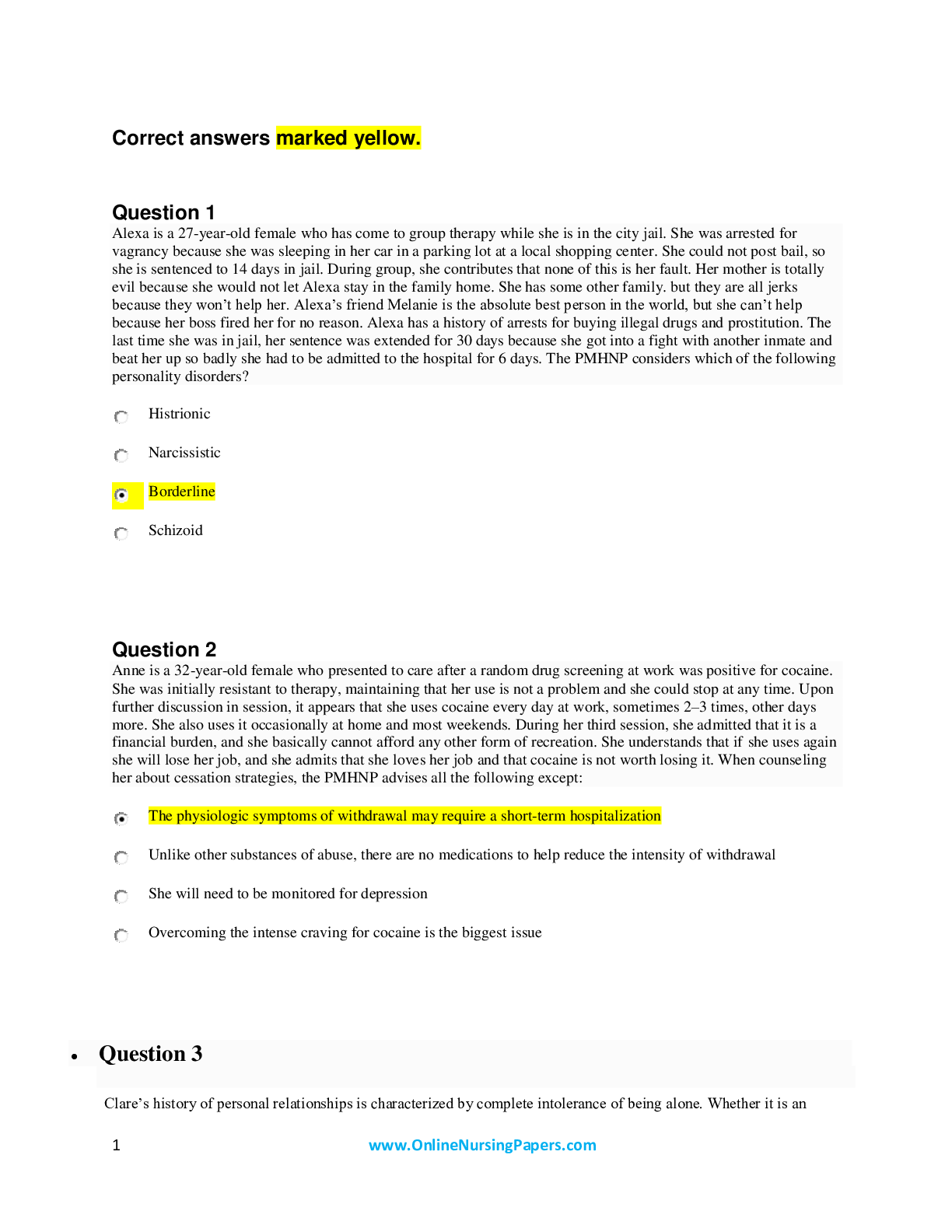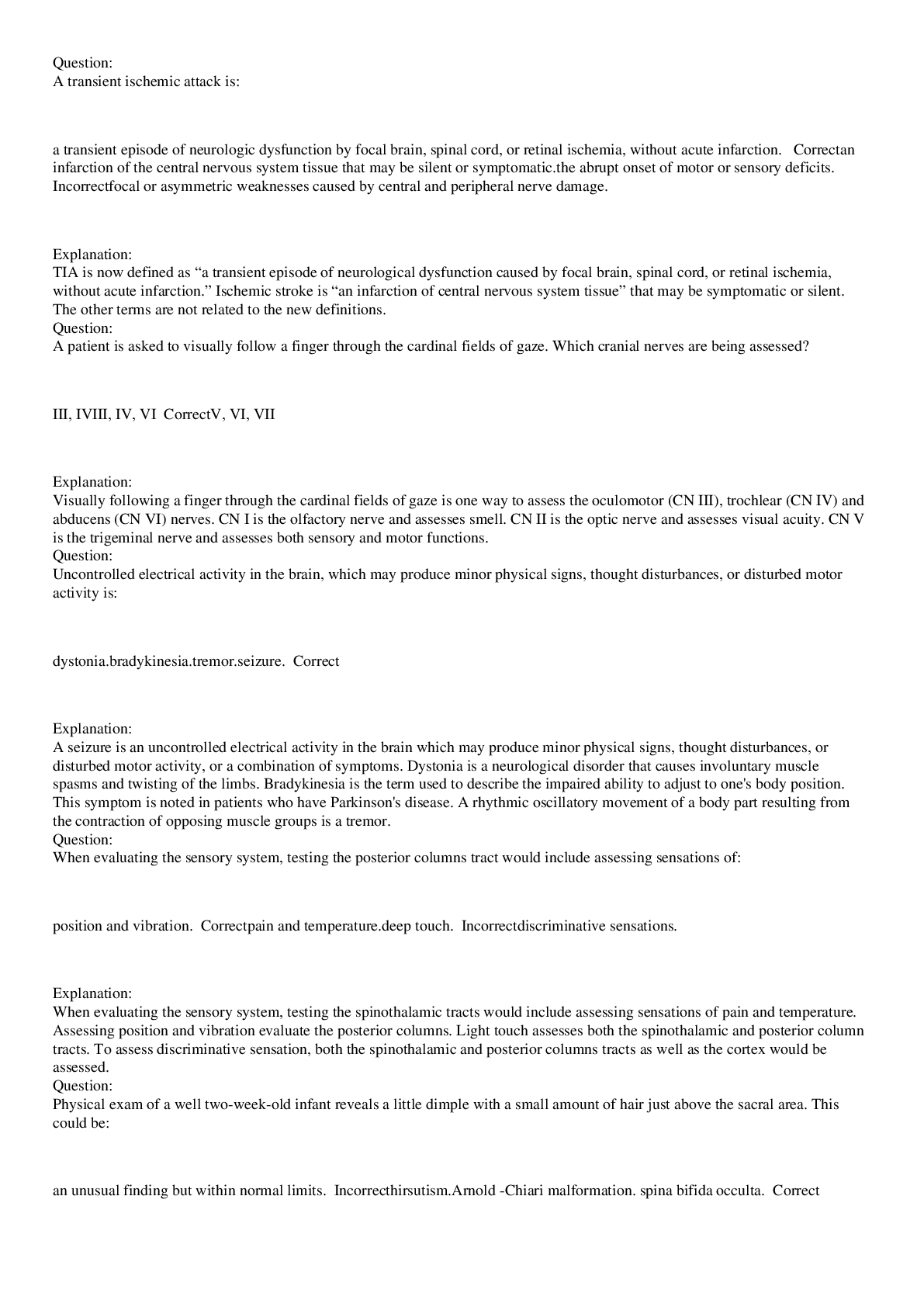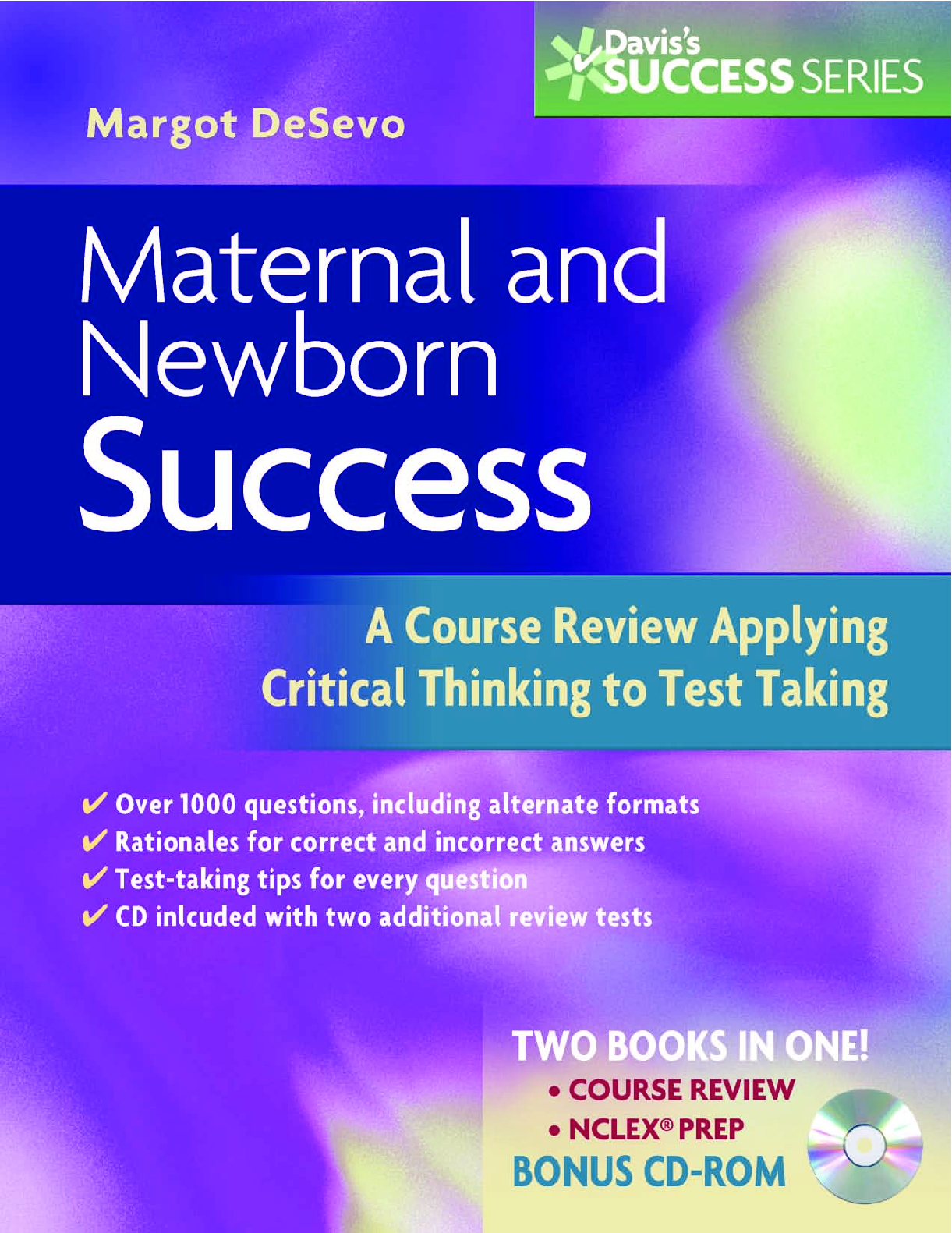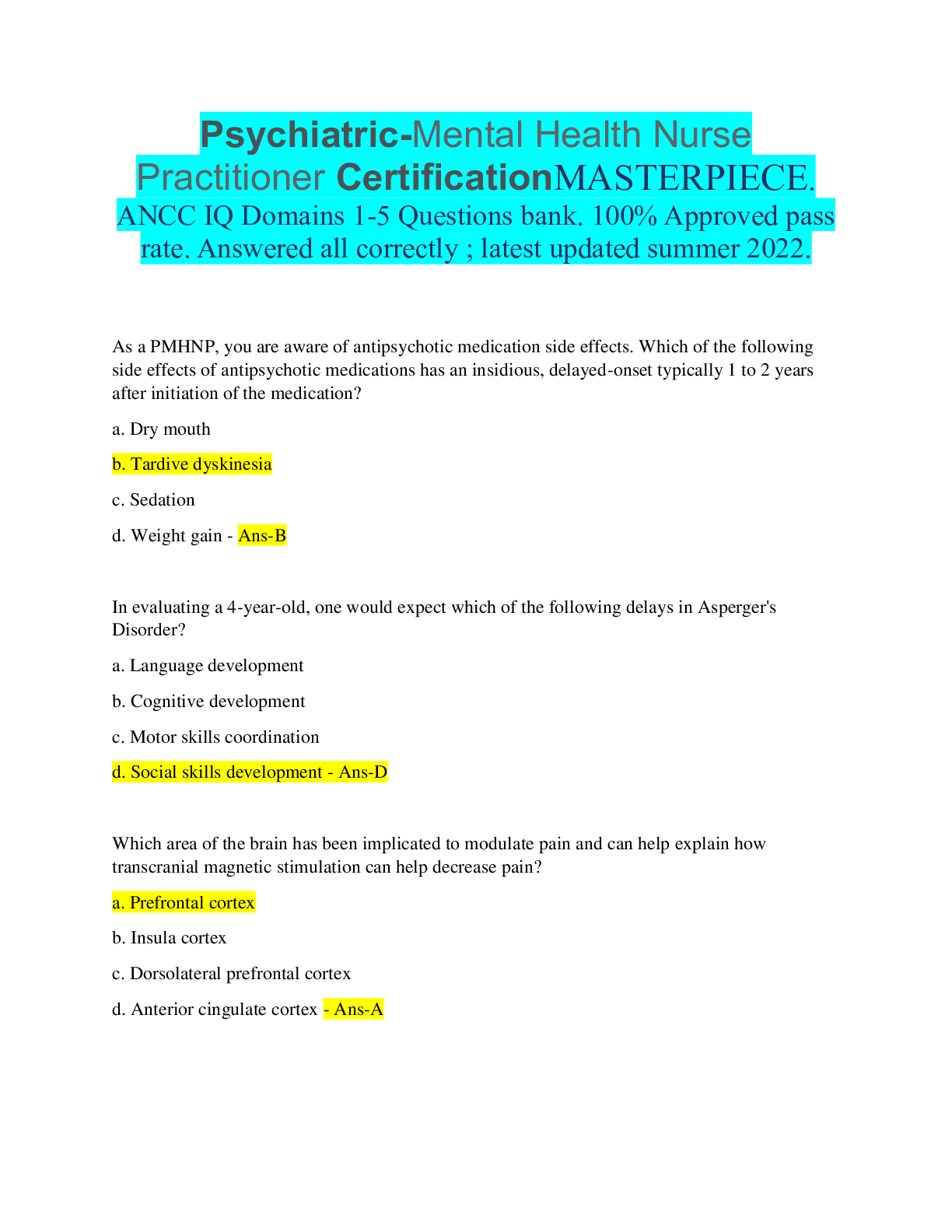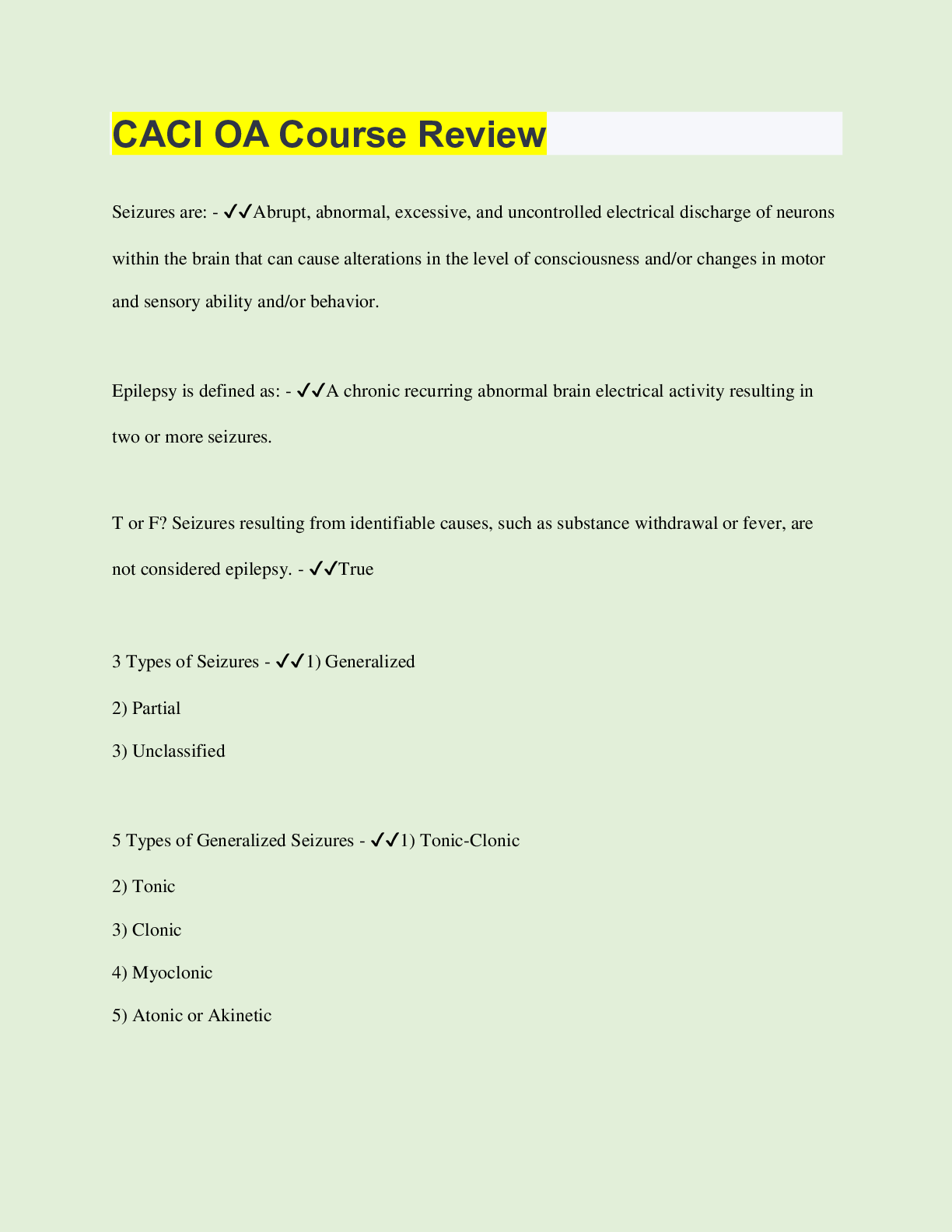Health Care > STUDY GUIDE > NUR 205-Maternal-Newborn-Success; A Course Review Applying Critical Thinking to Test Taking ;PRACTIC (All)
NUR 205-Maternal-Newborn-Success; A Course Review Applying Critical Thinking to Test Taking ;PRACTICE QUESTIONS ANSWERS AND RATIONALES
Document Content and Description Below
Maternal-Newborn-Success; A Course Review Applying Critical Thinking to Test Taking Introduction........................................................................................................ .........................1 How to Use This Book.............................................................................................................................1 Learn the Material....................................................................................................................................1 Read Assignments....................................................................................................................................2 Discuss the Information..........................................................................................................................2 Organize the Information........................................................................................................................2 Using the Nursing Process.....................................................................................................................4 Assessment ................................................................................................................................................4 Formulation of a Nursing Diagnosis.....................................................................................................4 Development of a Plan of Care .............................................................................................................4 Implementation.........................................................................................................................................5 Evaluation...................................................................................................................................................6 Types of Questions ...................................................................................................................................6 How to Approach Exam Questions .......................................................................................................9 2 Sexuality, Fertility, and Genetics ........................................................................11 KEYWORDS .............................................................................................................................................11 PRACTICE QUESTIONS........................................................................................................................12 Sexuality .............................................................................................................................................12 Infertility .............................................................................................................................................15 Genetics ..............................................................................................................................................21 PRACTICE QUESTION ANSWERS AND RATIONALES.................................................................30 Sexuality .............................................................................................................................................30 Infertility .............................................................................................................................................33 Genetics ..............................................................................................................................................40 3 Women’s Health Issues...............................................................................................53 KEYWORDS .............................................................................................................................................53 PRACTICE QUESTIONS........................................................................................................................54 PRACTICE QUESTION ANSWERS AND RATIONALES.................................................................69 4 Antepartum ..........................................................................................................................89 KEYWORDS .............................................................................................................................................89 PRACTICE QUESTIONS........................................................................................................................90 PRACTICE QUESTION ANSWERS AND RATIONALES...............................................................107 5 Intrapartum........................................................................................................................129 KEYWORDS...........................................................................................................................................129 PRACTICE QUESTIONS .....................................................................................................................130 PRACTICE QUESTION ANSWERS AND RATIONALES...............................................................145 6 Newborn................................................................................................................................163 KEYWORDS...........................................................................................................................................163 PRACTICE QUESTIONS .....................................................................................................................164 PRACTICE QUESTION ANSWERS AND RATIONALES...............................................................182 Contents xi 19067_FM_i-xii.qxd 6/4/09 7:13 PM Page xi xii MATERNITY SUCCESS 7 Normal Postpartum .....................................................................................................207 KEYWORDS...........................................................................................................................................207 PRACTICE QUESTIONS .....................................................................................................................207 PRACTICE QUESTION ANSWERS AND RATIONALES...............................................................222 8 High-Risk Antepartum...............................................................................................239 KEYWORDS...........................................................................................................................................239 PRACTICE QUESTIONS .....................................................................................................................240 PRACTICE QUESTION ANSWERS AND RATIONALES...............................................................257 9 High-Risk Intrapartum..............................................................................................281 KEYWORDS...........................................................................................................................................281 PRACTICE QUESTIONS .....................................................................................................................282 PRACTICE QUESTION ANSWERS AND RATIONALES...............................................................299 10 High-Risk Newborn......................................................................................................321 KEYWORDS...........................................................................................................................................321 PRACTICE QUESTIONS .....................................................................................................................322 PRACTICE QUESTION ANSWERS AND RATIONALES...............................................................340 11 High-Risk Postpartum ...............................................................................................365 KEYWORDS...........................................................................................................................................365 PRACTICE QUESTIONS .....................................................................................................................366 PRACTICE QUESTION ANSWERS AND RATIONALES...............................................................379 12 Comprehensive Examination................................................................................395 COMPREHENSIVE EXAMINATION ANSWERS AND RATIONALES .........................................411 Index ......................................................................................................................................431 19067_FM_i-xii.qxd 6/4/09 7:13 PM Page xii 1 Introduction 1 This book is part of a series published by the F. A. Davis Company designed to assist student nurses in reviewing essential information and in taking examinations, particularly the NCLEX-RN examination and certification exams. The book focuses predominantly on childbearing—the antepartum, intrapartum, postpartum, and newborn periods—and, because of the childbearing focus, also includes questions about fetal and neonatal development. In addition, because women are pregnant for such a short period of their lives, because childbearing occurs within the context of the family, and because embryonic and fetal development occur within the context of genetics, the text contains questions on those topics. Other subjects, including sexually transmitted illnesses, domestic violence, rape, and contraception that affect women during the childbearing years—which make up about one third of a woman’s life—are also included. As a result, this text is an excellent supplement for a number of nursing school courses, including Parent-Child Nursing, Fetal Growth and Development, Basic Genetics, Family Processes, and Women’s Health. To obtain the most from this book, the student is strongly encouraged to read the content related to the different topic areas and to study the material in a logical manner. Only if this is done will this book be valuable. Used as a supplement to foundational work, this book should be helpful in developing the skills needed to be successful on examinations, such as NCLEX and certification exams, in the relevant content areas. A discussion of the types of questions asked on examinations, of techniques for approaching test questions in order to identify what is being asked, and of how to select correct responses is included. HOW TO USE THIS BOOK This book contains 11 chapters and is accompanied by a CD-ROM with two comprehensive examinations. This introductory chapter focuses on the types of questions included in the NCLEX-RN examination and on how to approach studying and preparing for an examination. Chapters 2 through 11 focus on topics related to maternity nursing, most specifically the antepartum, intrapartum, postpartum, and newborn periods. Each of these chapters contains Practice Questions that test a student’s knowledge and Practice Question Answers and Rationales with specific tips on how to approach answering the question. The reasons why a particular answer is correct and the reasons why other answer options are incorrect are given. These serve as valuable learning tools for the student and help to reinforce knowledge. The two comprehensive CD-ROM examinations include questions—and answers—that cover all topics included in the 10 content chapters. The CD-ROM format will provide the test taker with practice in answering questions on the computer, a valuable help since the NCLEX-RN examination is computer based. LEARN THE MATERIAL The first step, before attempting to answer questions in this text—or on an examination— is to study and learn the relevant material. Learning does not mean simply reading textbooks and/or attending class. Learning is an active process that requires a number of complex skills, including reading, discussing, and organizing information. 19067_Ch01_001-010.qxd 6/4/09 7:02 PM Page 1 2 MATERNAL AND NEWBORN SUCCESS READ ASSIGNMENTS Students must first read their assignments. And, by far, the best time to read the assigned material is before the class in which the information will be discussed. Then, if students have any questions about what was read, they can ask the professor during class and clarify anything that is confusing. In addition, students will find discussions much more meaningful when they have a basic understanding of the material. DISCUSS THE INFORMATION During class time, material should be discussed with students rather than fed to them. Certainly, professors have an obligation to provide stimulating and thought-provoking classes, but students also have an obligation to be prepared to engage in discussions upon entering the classroom. Although facts must be learned, nursing is not a fact-based profession. Nursing is an applied science. Nurses must know information but, more importantly, they must use information. When a nurse enters a client’s room, the client rarely asks the nurse to define a term or to recite a fact. Rather the client presents the nurse with a set of data that the nurse must interpret and act on. In other words, the nurse must think critically. Students, therefore, must discuss client-based information by asking “why” questions rather than simply learning facts by asking “what” questions. ORGANIZE THE INFORMATION While reading and discussing information, nursing students must begin to organize their knowledge. Nursing knowledge cannot be memorized! There is too much information to be memorized and, more important, memorization negatively affects the ability to use information. Nurses must be able to analyze data critically in order to determine priorities and actions. In order to think critically, nurses must have developed connections between and among information. There are several steps in a pathway for organizing basic information, including understanding the pathophysiology of the problem; determining its significance for the particular client; identifying signs and symptoms; and using the steps of the nursing process: assessment, formulation of a nursing diagnosis, development of a plan of care, implementation of that plan, and evaluation of the outcomes. An example—a woman with a medical diagnosis of placenta previa—is used below and throughout the remainder of this chapter to illustrate the use of these interrelated steps to provide a pathway for organizing basic information. Whether studying for an examination or using skills in a specific clinical situation, it is often helpful to show graphically the relationships between and among various pieces of information, as is also done below. Example: A client has placenta previa. The nurse must first understand the problem, determine its significance, and assess for signs and symptoms. Understand the Problem The first action is to understand (not memorize) the pathophysiology of the issue or problem. (Implicit in this example is the prerequisite that the learner already fully understands the normal anatomy and physiology of pregnancy.) The placenta usually attaches to a highly vascular site in the decidua on the posterior wall of the uterus. Women who have compromised uterine vascularity—women who are multiparous, are smokers, have diabetes, or are carrying multiple gestations, for example—are at high risk for placenta previa. In this condition, the placenta, rather than attaching to the posterior portion of the uterine wall, attaches to an area immediately above or adjacent to the internal os of the uterus. 19067_Ch01_001-010.qxd 6/4/09 7:02 PM Page 2 Determine the Significance of the Pathophysiology The second phase of the process is to determine the significance of the pathophysiology. Often the nurse is able to deduce the significance based on knowledge of normal anatomy and physiology. Because the placenta is the highly vascular organ that supplies oxygen and nutrients to the developing baby, it is essential to the well-being of the fetus. If the cervix were to dilate or be injured, the chorionic villi of the placenta would be disrupted. The mother would lose blood, and the baby’s oxygenation and nutrition would be critically affected, resulting in a life-threatening situation for both mother and fetus. CHAPTER 1 INTRODUCTION 3 Predisposing factors: too little intrauterine space/ poor vascularity of the decidua Placenta attaches to area immediately above or adjacent to the internal os of the uterus Predisposing factors: too little intrauterine space/ poor vascularity of the decidua Placenta attaches to area immediately above or adjacent to the internal cervical os Cervical dilation and/or placental injury vaginal bleeding and fetal hypoxia Identify Signs and Symptoms Once the significance of the pathophysiology is deduced, it is essential to identify the signs and symptoms that are expected. In the mother, the nurse would expect to see bleeding with its associated changes in hematological signs (hematocrit and hemoglobin), vital signs, and anxiety. Because the placental bleeding will be unobstructed—that is, the blood will be able to escape easily via the vagina, the nurse would expect that the client would be in little to no pain and that the blood would be bright red. In addition, the nurse would expect the client’s hematological signs to be affected and the vital signs to change. However, because women have significantly elevated blood volumes during pregnancy, the pulse rate will elevate first, while the blood pressure will stay relatively stable. A drop in blood pressure is a late, and ominous, sign. In addition, the nurse would expect the mother to be anxious regarding her own and her baby’s well-being. In the fetus, if there were significant maternal blood loss and placental disturbance, the nurse would expect to see adverse changes in heart rate patterns. Late decelerations result from poor uteroplacental blood flow. Predisposing factors: too little intrauterine space/ poor vascularity of the decidua Placenta attaches to area immediately above or adjacent to the internal cervical os Cervical dilation vaginal bleeding and fetal hypoxia Mother: bright red, painless bleeding; pulse rate; hgb and hct; BP late sign; anxiety Fetus: late decelerations seen on external fetal monitor tracing Once the problem and the data concerning it are understood, the significance determined, and expected signs and symptoms identified, it is time for the student (and nurse) to turn to the nursing process. 19067_Ch01_001-010.qxd 6/4/09 7:02 PM Page 3 USE THE NURSING PROCESS The nursing process is foundational to nursing practice. To provide comprehensive care to their clients, nurses must understand and use each part of the nursing process—assessment, formulation of a nursing diagnosis, development of a plan of care, implementation of that plan, and evaluation of the outcomes. Assessment Nurses gather a variety of information during the assessment phase of the nursing process. Some of the information is objective, or fact-based. For example, noting a client’s hematocrit and noting other blood values in the chart are fact-based data that the nurse can use to determine a client’s needs. But, in addition, nurses must identify subjective data, or information as perceived through the eyes of the client. A client’s rating of her pain is an excellent example of subjective information. Nurses must be aware of which data must be assessed since each and every client situation is unique. In other words, nurses must be able to use the information taught in class and individualize it for each client interaction in order to determine which objective data must be accessed and which questions should be asked of the client. Once the data have been obtained, the nurse analyzes the information, as noted above. Formulation of a Nursing Diagnosis After the nurse has analyzed the data from his or her assessments, a nursing diagnosis is made. Nurses are licensed to treat actual or potential health problems. Nursing diagnoses are statements of the health problems that the nurse, in collaboration with the client, has concluded are critical to the client’s well-being. Example (continued) Based on the data above, the nurse now must develop the nursing diagnoses and prioritize the diagnoses as they relate to the care of a client with placenta previa. Since a woman with placenta previa may or may not begin to bleed, it is essential that the nurse develop two sets of diagnoses: one aimed at preventing complications—that is, “risk for” diagnoses—and one directed at the worst-case scenario—that is, if the client should start to bleed. The “risk for” nursing diagnoses for the example given above are: • Risk for maternal imbalanced fluid volume related to (r/t) hypovolemia secondary to excessive blood loss • Risk for impaired fetal gas exchange r/t decreased blood volume and maternal cardiovascular compromise • Maternal anxiety r/t concern for personal and fetal health The worst-case scenario (active bleeding) nursing diagnoses are: • Imbalanced maternal fluid volume r/t hypovolemia secondary to excessive blood loss • Impaired fetal gas exchange r/t decreased blood volume and maternal cardiovascular compromise • Maternal anxiety r/t concern for personal and fetal health Development of a Plan of Care During the planning phase, the nurse develops a plan of care including goals of care, expected client outcomes, and interventions necessary to achieve the goals and outcomes. In other words, the nurse determines what he or she wishes to achieve in relation to each of the nursing diagnoses and how he or she expects to go about meeting those goals. 4 MATERNAL AND NEWBORN SUCCESS 19067_Ch01_001-010.qxd 6/4/09 7:02 PM Page 4 One very important part of this process is the development of the priorities of care. The nurse must determine which diagnoses are the most important and, consequently, which actions are the most important. For example, a client’s physical well-being must take precedence over his or her emotional well-being. Plus, it is essential that the nurse consider the client’s own priorities. And, of course, nurses must consider the goals and orders of the client’s primary health care provider. Example (continued) The nurse develops a plan of care based on the nursing diagnoses listed above. Since the physical conditions must take precedence, the nurse prioritizes the plan with the physical needs first. The client’s emotional needs will then be considered. The plan of care to meet the “at risk” nursing diagnoses is shown in Box 1-1 and a plan for the worst-case scenario—active bleeding—is shown in Box 1-2. Implementation Once the plan is established, the nurse then implements the plan. The plan may include direct client care by the nurse and/or care that is coordinated by the nurse but performed by other practitioners. It is important to note that if assessment data change during the implementation phase, the nurse must reanalyze the data, change diagnoses, and reprioritize his or her care. One very important aspect of any and all nursing care is that it be evidence-based. Nurses are independent practitioners. They are mandated to provide safe, therapeutic care that has a scientific basis. Nurses, therefore, must engage in life-long learning. It is essential that nurses realize that much of the information in textbooks is outdated before the text was even published. In order to provide evidence-based care, nurses must keep their knowledge current by accessing information from reliable sources on the Internet, in professional journals, and at professional conferences. Example The plan should be implemented as developed during the planning phase. If a situation should change, for example, the woman should begin to bleed spontaneously during a shift, the nurse would immediately revise his or her plan, as needed. In the example cited, the nurse would implement the active bleeding plan of care. CHAPTER 1 INTRODUCTION 5 BOX 1-1 Plan of Care for Client with Placenta Previa at Risk for Bleeding Nursing Diagnosis: Risk for imbalanced fluid volume (maternal) related to (r/t) hypovolemia secondary to excessive blood loss. Goal: Client will not bleed throughout the pregnancy. Proposed Actions: The nurse will: • Assess for vaginal bleeding each shift. • Assess for uterine contractions each shift. • Assess vital signs each shift. • Assess intake and output during each shift. • Assess bowel function each shift. • Insert nothing into the vagina. • Maintain client on bed rest, as ordered. • Monitor changes in laboratory data, as ordered. Nursing Diagnosis: Risk for impaired gas exchange (fetal) r/t decreased blood volume and maternal cardiovascular compromise. Goal: The fetal heart rate will show average variability and no decelerations until delivery. Proposed Actions: The nurse will: • Monitor fetal heart rate every shift. • Do nonstress testing, as ordered. Nursing Diagnosis: Anxiety (maternal) r/t concern for personal and fetal health. Goal: The mother will exhibit minimal anxiety throughout her pregnancy. Proposed Actions: The nurse will: • Provide emotional support. 19067_Ch01_001-010.qxd 6/4/09 7:02 PM Page 5 Evaluation The evaluation phase is usually identified as the last phase of the nursing process, but it also could be classified as another assessment phase. When nurses evaluate, they are reassessing clients to determine whether or not the actions taken during the implementation phase met the needs of the client. In other words, “Were the goals of the nursing care met?” If the goals were not met, the nurse is obligated to develop new actions to meet the goals. If some of the goals were met, priorities may need to be changed. And, so on. As can be seen from this phase, the nursing process is ongoing and ever changing. Example (continued) Throughout the nursing care period, the nurse is assessing and reassessing the situation. If needed, the nurse may report significant changes to the health care provider or may independently determine that a change in nursing care is needed. For example, if the client begins to cry because she is concerned about her baby’s health, and physiologically the client is stable, the nurse can concentrate on meeting the client’s emotional needs. The nurse may sit quietly with the client while she communicates her concerns. Conversely, if the client begins to bleed profusely, the nurse would immediately report the change to the client’s health care provider and implement the active bleeding plan. TYPES OF QUESTIONS There are four Integrative Processes upon which questions on the NCLEX-RN are based: The Nursing Process, Caring, Communication and Documentation, and Teaching/Learning (Test Plan for NCLEX-RN 2007). The test taker must determine which process(es) is (are) being evaluated in each question. In other words, the test taker must realize that because nursing is an action profession, the NCLEX-RN questions simulate, in a written format, clinical situations. Critical reading by the test taker is, therefore, essential. 6 MATERNAL AND NEWBORN SUCCESS BOX 1-2 Plan of Care for Patient with Placenta Previa Who Is Bleeding Nursing Diagnosis: Imbalanced fluid volume (maternal) r/t hypovolemia secondary to excessive blood loss. Goal: Client will become hemodynamically stable. Proposed Interventions: The nurse will: • Measure vaginal bleeding. • Count number of saturated vaginal pads. • Weigh pads—1 gm ! 1 mL of blood. • Monitor for uterine contraction pattern, if present. • Assess vital signs every 15 minutes. • Assess oxygen saturation levels continually. • Assess intake and output every hour. • Insert nothing into the vagina. • Maintain client on bed rest. • Monitor changes in laboratory data, as ordered. • Administer intravenous fluids, as ordered. • Prepare for emergency Cesarean section, as ordered. Nursing Diagnosis: Risk for impaired gas exchange (fetal) r/t decreased blood volume and maternal cardiovascular compromise. Goal: The fetal heart rate will show average variability and no late decelerations. Proposed Interventions: The nurse will: • Monitor fetal heart rate continually via external fetal monitor. Nursing Diagnosis: Anxiety (maternal) r/t concern for personal and fetal health Goal: The mother will exhibit minimal anxiety. Proposed Interventions: The nurse will: • Provide clear, calm explanations of all assessments and actions. • Provide emotional support. 19067_Ch01_001-010.qxd 6/4/09 7:02 PM Page 6 Most of the questions asked on the NCLEX-RN exam are multiple choice questions. Other types of questions, known as alternate-type questions, include fill-in-the-blank questions, multiple-response questions, drag-and-drop questions, hot spot items, and chart or exhibit items. The types of questions and examples of each are discussed below. Multiple-Choice Questions In multiple-choice questions, a stem is provided and the test taker must choose among four possible responses. Sometimes the test taker will be asked to choose the best response, sometimes to choose the first action that should be taken, and the like. There are numerous ways that multiple-choice questions may be asked. Below is but one example related to a client with placenta previa. Example: A client, 36 weeks’ gestation, has been diagnosed with a complete placenta previa. The client tells the nurse that she has a bad backache that comes and goes. Which of the following actions should the nurse perform first? 1. Give the client a back rub. 2. Assess the client’s vital signs. 3. Time the client’s back pains. 4. Assess for vaginal bleeding. Answer: 4 The nurse must realize that since the backache comes and goes that this client may be in early labor. And since dilation of the cervix can lead to bleeding, the nurse must first assess for placental injury—vaginal bleeding. Fill-in-the-Blank Questions Fill-in-the-blank questions are calculation questions. The test taker may be asked to calculate a medication dosage, an intravenous (IV) drip rate, a minimum urinary output, or other factor. Included in the question will be the units that the test taker should have in the answer. Example: The nurse caring for a client with placenta previa must determine how much blood the client has lost. The nurse weighs a clean vaginal pad (5 gm) and the client’s saturated pad (25 gm). How many milliliters of blood has the client lost? ____ mL Answer: 20 mL. The test taker must subtract 5 from 25 to determine that the client has lost 20 gm of blood. Then, knowing that 1 gm of blood is equal to 1 mL of blood, the test taker knows that the client has lost 20 mL of blood. Drag-and-Drop Questions In drag-and-drop questions, the test taker is asked to place four or five possible responses in chronological or rank order. The responses may be actions to be taken during a nursing procedure, steps in growth and development, and the like. The items are called drag-anddrop questions since the test taker will move the items with his or her computer mouse. Needless to say, in this book, the test taker will simply be asked to write the responses in the correct sequence. Example: The nurse must administer a blood transfusion to a client with placenta previa who has lost a significant amount of blood. Please put the following nursing actions in the chronological order in which they should be performed. 1. Stay with client for a full 5 minutes and take a full set of vital signs. 2. Compare the client’s name and hospital identification number with the name and number on the blood product container. 3. Check the physician’s order regarding the type of infusion that is to be administered. 4. Regulate the infusion rate as prescribed. CHAPTER 1 INTRODUCTION 7 19067_Ch01_001-010.qxd 6/4/09 7:02 PM Page 7 Answer: 3, 2, 4, 1 Of the four steps included in the answer options, the order should be 3, 2, 4, 1. The nurse must first check the physician’s order to determine exactly what blood product is being ordered. Second, the nurse must compare the information on the blood product bag with the client’s name band. This must be done with another nurse or a doctor. Third, the nurse must begin the infusion and regulate the infusion. Finally, the nurse must closely monitor the client during the first 5 minutes of the infusion to assess for any transfusion reactions. At the end of the 5 minutes, a full set of vital signs must be taken. Multiple-Response Questions When the test taker sees the statement “Select all that apply” after a question, he or she should know that the examiner has included more than one correct response to the question. Usually there will be five responses given and the test taker must determine which of the five responses are correct. There may be two, three, four, or even five correct responses. Example: A nurse is caring for a client, 28 weeks’ gestation, with placenta previa. Which of the following physician orders should the nurse question? Select all that apply. 1. Encourage ambulation. 2. Weigh all vaginal pads. 3. Assess cervical dilation daily. 4. Perform a nonstress test every morning. 5. Administer Colace 100 mg PO three times a day Answer: 1 and 3 are correct. Because the placenta could be injured, no vaginal examinations should be performed; therefore, the nurse should question #3—assess cervical dilation daily. Also, because bleeding may occur, clients with placenta previa are allowed only minimal activity; therefore, ambulation would not be encouraged. Hot Spot Items Hot spot items require the test taker to identify on a picture, graph, or other image, the correct response to a question. For example, a test taker may be asked to place an “X” on the location of a P wave on an electrocardiogram strip. Example: Below is a diagram of the uterus. Place an “X” where a complete placenta previa would be attached. Answer: The test taker should place an “X” on the internal os of the cervix. 8 MATERNAL AND NEWBORN SUCCESS 19067_Ch01_001-010.qxd 6/4/09 7:02 PM Page 8 Chart/Exhibit Items Some questions may include a chart or exhibit. The test taker is asked to interpret the data, identify the locations of data, or perform a calculation based on information given in the chart/exhibit. Example: While caring for a client who had an emergency cesarean section because of active bleeding related to complete placenta previa, the nurse aide has emptied the Foley catheter three times during an 8-hour shift. How many mL of urine has the client voided during the shift? Answer: 250 mL (60 + 90 + 100 = 250) CHAPTER 1 INTRODUCTION 9 Urine Output for 8-Hour Shift 7 a.m. 8 a.m. 60 mL 9 a.m. 10 a.m. 11 a.m. 90 mL 12 p.m. 1 p.m. 2 p.m. 3 p.m. 100 mL TOTAL HOW TO APPROACH EXAM QUESTIONS There are several techniques that a test taker should use when approaching examination questions. • Pretend that the examination is a clinical experience—First and foremost, test takers must approach critical thinking questions as if they were in a clinical setting and the situation were developing in situ. Virtually all critical-thinking questions are clinically focused. If the test taker pretends he or she is in a clinical situation, the importance of the response becomes evident. In addition, the test taker is likely to prepare for the examination with more commitment. That is not to say that students are rarely committed to doing well on examinations, but rather that they often approach examinations differently than they approach clinical situations. It is a rare nurse who goes to clinical not having had sufficient sleep to care for his or her clients, and yet students often enter an examination room after only 2 or 3 hours of sleep. The student needs the same critical thinking ability that sleep provides when in an exam as a nurse needs on a clinical unit. It is essential that test takers be well rested before all exams. • Read the stem carefully before reading the responses—As discussed above, there are a number of different types of questions on the NCLEX-RN examination and most faculty are including alternate-format questions in their classroom examinations as well. Before answering any question, the test taker must be sure, therefore, what the questioner is asking. This is one enormous drawback of classroom examinations. A test taker standing in a client’s room is much less likely to misinterpret the situation when he or she is facing a client than when reading a question on an examination. • Consider possible responses—After clearly understanding the stem of the question, but before reading the possible responses, the test taker should consider possible correct answers to the question. It is important for the test taker to realize that test writers only include plausible answer options. A test writer’s goal is to determine whether or not the test taker 19067_Ch01_001-010.qxd 6/4/09 7:02 PM Page 9 knows and understands the material. The test taker, therefore, must have an idea of what the correct answer might be before beginning to read the possible responses. • Read the responses—Only after clearly understanding what is being asked and after developing an idea of what the correct answer might be should the test taker read the responses. The one response that is closest in content to the test taker’s “guess” should be the answer that is chosen, and the test taker should not second guess himself or herself. The first impression is almost always the correct response. Only if the test taker knows that he or she misread the question, should the answer be changed. • Read the rationales for each question—In this book, rationales are given for each answer option. The student should take full advantage of this feature. Read why the correct answer is correct. The rationale may be based on content, on interpretation of information, or on a number of other bases. Understanding why the answer to one question is correct is likely to transfer over to other questions with similar rationales. Next, read why the wrong answers are wrong. Again, the rationales may be based on a number of different factors. Understanding why answers are wrong also may transfer over to other questions. • Finally, read all test taking tips—Some of the tips relate directly to test-taking skills, while others include invaluable information for the test taker. If the test taker uses this text as recommended above, he or she should be well prepared to be successful when taking an examination in any or all of the content areas represented. And, as a result, the test taker should be fully prepared to function as a beginning registered professional nurse in the many areas of maternity and women’s health. 10 MATERNAL AND NEWBORN SUCCESS 19067_Ch01_001-010.qxd 6/4/09 7:02 PM Page 10 11 Sexuality, Fertility, and Genetics 2 Before pregnancy can begin, a sperm and an ovum must unite. This usually occurs during sexual intercourse but can be accomplished via artificial insemination, in vitro fertilization, and a number of other procedures used in attempts to overcome infertility. The nurse must be familiar with the male and female reproductive systems in order to understand why normal procreation occurs and why, in some instances, a woman fails to become pregnant. This chapter includes questions on three related issues surrounding the process of reproduction: sexuality, infertility, and genetics. Since genetics involves much more than simply parents and their offspring, additional concepts are included in the genetics section. KEYWORDS allele amniocentesis aneuploidy autosomal dominant inheritance autosomal recessive inheritance autosome basal body temperature chorionic villus sampling (CVS) chromosome corpus cavernosum corpus luteum corpus spongiosum deoxyribonucleic acid (DNA) diploid Down syndrome ejaculatory duct endometrial biopsy epididymis estrogen expressivity fallopian tubes familial adenomatous polyposis (FAP) ferning capacity fertilization fimbriae follicle-stimulating hormone (FSH) follicular phase fragile X syndrome gametes gametogenesis gene genetics genome genotype GIFT (gamete intrafallopian transfer) glans gonadotropin-releasing hormone graafian follicle haploid human chorionic gonadotropin Huntington’s disease hysterosalpingogram hysteroscopy infertility in vitro fertilization ischemic phase karyotype laparoscopy luteal phase luteinizing hormone (LH) meiosis menses menstrual cycle menstrual phase mitochondrial inheritance mitosis monosomy oogenesis ovary ovulation ovum pedigree 19067_Ch02_011-052.qxd 6/4/09 7:03 PM Page 11 12 MATERNAL AND NEWBORN SUCCESS penetrance phenotype phenylketonuria polycystic kidney disease (PKD) prepuce progesterone proliferative phase prostate ribonucleic acid (RNA) scrotum secretory phase seminal vesicle sex chromosome spermatogenesis spinnbarkeit surrogate testes trisomy urethra uterus vagina vas deferens X-linked recessive inheritance Y-linked inheritance ZIFT (zygote intrafallopian transfer) [Show More]
Last updated: 1 year ago
Preview 1 out of pages

Buy this document to get the full access instantly
Instant Download Access after purchase
Add to cartInstant download
We Accept:

Reviews( 0 )
$20.00
Document information
Connected school, study & course
About the document
Uploaded On
Apr 07, 2021
Number of pages
Written in
Additional information
This document has been written for:
Uploaded
Apr 07, 2021
Downloads
0
Views
2


